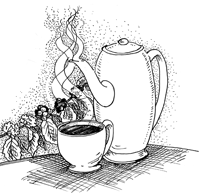STRANGE BUT TRUE- Buzz: Robusta to arabica, coffee does the trick

DRAWING BY DEBORAH DERR McCLINTOCK
Q. It's the second most heavily traded commodity in the world after petroleum products, with a retail value of $70+ billion and 100+ million people depending on it for their livelihood. Originating in Africa, it eventually spread to the Middle East, to Europe, to South and Central America and beyond. Derived from berry seeds of a family of flowering plants, it has over 100 species (though only two are commonly traded). Its kick comes from the alkaloid 1,3,7-trimethylxanthine and, when roasted, it releases more than 800 detectable volatile compounds in its aroma. Try to identify this popular, decidedly addictive "black wine"? –S. Joe
A. Perhaps you're at your favorite coffeehouse having a cup as you read this. Then you're probably enjoying either "coffea arabica" or "coffea canephora" (also known as robusta), the two most common varieties, says Fernando Vega in American Scientist. The first record of coffee as a beverage dates to about 1450 in Yemen, and that alkaloid-kicker is, of course, caffeine.
Q. What are the most forensically significant features of footprints left at the scene of a crime? –T. Longo
A. The "accidental marks" unique to a particular pair of shoes, says Cathy Cobb in Crime Scene Chemistry for Armchair Sleuths. A plaster cast of the treads can help identify shoe type and manufacturer, but it takes a comparison of these telltale marks to tie a particular shoe to a particular print. (Casts of tire prints can be analyzed in a similar manner.)
Accidental marks were critical in a case involving a Peeping Tom terrorizing a neighborhood one winter. At every scene he left clear prints in the snow, which he didn't bother to cover up. Using special materials, police were able to get several prints, but no accidentals were discernible in any of them. Puzzled, they theorized that the culprit's shoes had no accidentals because they had no history: he wore a brand new pair of shoes every time. And when police finally arrested a suspect, his occupation turned out to be shoe store owner. Case closed!
Q. If a month begins and ends on a Friday, what month is it? –F. Time
A. From Friday the 1st to Thursday the 7th is seven days, then 14 to the next Thursday, then 21 and 28. One more day to the 5th Friday totals 29 days, so this wouldhave to be February of a leap year (as in 2008). Not a bad month with five possible paydays and no Friday the 13th. (From Hard-to-Solve Brainteasers by Jaime and Lea Poniachik)
Q. Imagine a political candidate who looks virtually like your twin. Would that be enough to win your vote? –H. Clinton
A. Something close to this has been experimentally tested at Stanford University, notes Greg Miller in Science magazine. During the Bush/Kerry U.S. presidential race of 2004, social science researchers asked subjects to choose between a picture of John Kerry and a picture of George Bush, but with a sly twist: in some of the tests, one of the candidate's pictures had his face "morphed" to look somewhat like the subject's own face while the other one stayed as an actual photo. And– you guessed it– most test subjects went for the candidate looking more like themselves. The more partisan they were, however, the more they resisted this self-morphing influence. Of course, politicians have long adapted themselves to look more like their audience– "donning overalls for a meeting with farmers, then switching to a suit for a meeting with business executives," and so on, says Miller.
Q. You're on a busy city street giving directions to a construction worker, a stranger, who suddenly changes into a different person wearing different-colored clothes. Do you think you would notice the switch? –T. Leary
A. Don't be so sure! In an actual study of this sort, subjects were set up to be giving directions when suddenly two people (confederates of the experimenter) carried a large board past, momentarily hiding the "worker" from view. Then a second worker surreptitiously replaced the first.
Amazingly, most of the subjects were so focused on their task that they failed to notice they were now talking to a different person, says David G. Myers in Psychology: Seventh Edition in Modules. For each of us, our five senses take in an estimated 11 million bits of information every second, yet we consciously process only about 40!
In tests where people heard two different messages simultaneously over a headset, one in each ear, and were asked to repeat the left message as it occurred, they could do this but then could say nothing about the right message– except the speaker's gender and loudness. The listeners couldn't even state the language of the second message.
"Whatever has our conscious attention pretty much has our undivided attention," Myers notes.
Send Strange questions to brothers Bill and Rich at [email protected].
#